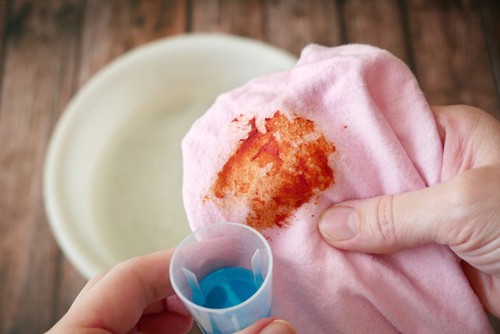
How to Remove Ink, Oil, and Grease Stains from Clothes
How to Remove Ink, Oil, and Grease Stains from Clothes? Ink, oil, and grease stains can harm our existence, especially when they find their way onto our favorite clothing.
These are among the most common stains we encounter. They are also some of the most stubborn to remove, often requiring specific techniques and some elbow grease.
Stains, especially those of ink, oil, or grease, can ruin the aesthetics of clothing. They also impact the garment’s durability by attracting dirt and causing fabric fibers to break down more quickly.
This article aims to equip you with effective techniques for removing these stubborn stains from different fabrics and clothing items. Read on – How to Remove Ink, Oil, and Grease Stains from Clothes?
Understanding Different Stain Types
Table of Contents
Characteristics of Ink Stains
Ink stains are colored, usually causing dark spots on clothing. They can penetrate deep into the fabric fibers, making them hard to remove.
Types of Oil and Grease Stains
Oil and grease stains are usually caused by cooking, machinery, or automotive oils. They leave a dark, wet-looking spot on the fabric, which can be sticky and attract more dirt if not removed promptly.
Quick Action for Stain Removal
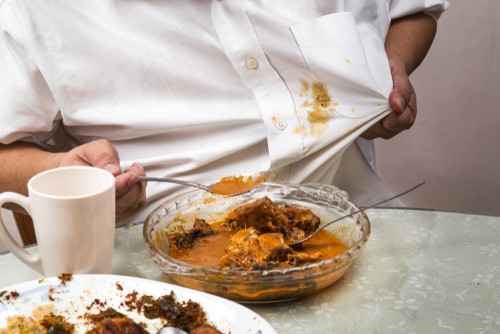
Blotting vs. Rubbing: The Right Approach
When dealing with fresh stains, blotting is your best approach. This method lifts the stain from the fabric rather than spreading it, as rubbing would.
Precautions Before Applying Stain Removal Techniques
Before you begin, always read the care label on your clothing item. If it indicates “dry clean only,” it’s best to take it to a professional cleaner. For washable items, perform a spot test with your chosen cleaning solution on an inconspicuous area of the garment to ensure it won’t damage or discolor the fabric.
Removing Ink Stains
Ink Stain Removal Based on Fabric Type
For cotton or polyester, you can try an alcohol-based solution like rubbing alcohol or hand sanitizer. Apply it to the stain using a cotton ball and gently dab. Rinse thoroughly after the stain is gone.
Use a professional dry cleaning solvent for delicate fabrics like silk or wool or take the item to a dry cleaner to prevent damage.
Alcohol-Based Solutions for Ink Stains
Isopropyl alcohol or rubbing alcohol is highly effective on ink stains. Dab it onto the stain with a cotton ball, let it sit for a few minutes, then rinse thoroughly.
Alternative Methods: Hairspray, Vinegar, and Milk
Old-fashioned hairspray, white vinegar, or milk can also be effective in removing ink stains. Spray hairspray directly onto the stain, then blot with a clean cloth. For white vinegar or milk, soak the stained garment in it for 30 minutes, then wash as usual.
Tackling Oil Stains
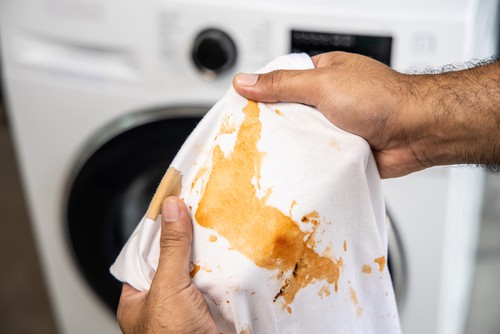
Absorbing Excess Oil from the Fabric
When oil spills on your clothing, remove excess oil by blotting the stain with a clean cloth or paper towel. Do not rub, as this can spread the stain.
Dish Soap and Warm Water Method
Liquid dish soap is designed to cut through grease and is safe for most fabrics. Apply it to the stain, gently rub with a toothbrush, then rinse with warm water.
Applying Cornstarch or Talcum Powder for Stubborn Stains
For stubborn or older oil stains, apply a thick layer of cornstarch or talcum powder and let it sit for a few hours. Brush off the powder, then treat with dish soap as described above.
Dealing with Grease Stains
Pre-Treating Grease Stains with Dish Soap or Liquid Laundry Detergent
Pre-treat grease stains with liquid dish soap or a grease-fighting liquid laundry detergent. Apply it directly to the stain, let it sit for a few minutes, then rinse with warm water.
Using Baking Soda and Vinegar Solution
Baking soda is a natural deodorizer and cleaner, while white vinegar is a natural stain remover. Make a paste with three parts baking soda to one part vinegar, apply to the stain, let sit for an hour, then wash as usual.
Hot Water and Ammonia Method for Tough Grease Stains
For stubborn grease stains, try a mixture of hot water and a few drops of ammonia. Apply to the stain and blot with a clean cloth. Always use in a well-ventilated area and never mix with bleach, as this can create harmful gases.
Stain Removal for Specific Fabrics
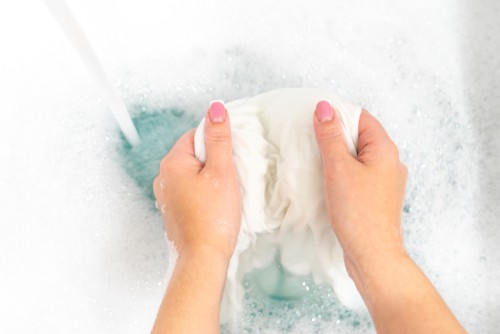
Removing Stains from Cotton and Polyester
Cotton and polyester are sturdy fabrics and can usually be treated with any of the methods described above.
Treating Stains on Delicate Fabrics like Silk and Wool
Silk and wool require careful handling to prevent damage. Blot the stain gently, then take to a dry cleaner. Alternatively, use a specialty stain remover designed for delicate fabrics.
Special Care for Leather and Suede Clothing
Leather and suede should always be taken to a professional for stain removal to avoid damaging the material.
Tips for Handling Set-In Stains
Identifying Set-In Stains and Their Challenges
Set-in stains are stains that have dried or been “set” into the fabric, typically after a garment has been dried or ironed. They can be difficult to remove, often requiring multiple treatments.
Soaking and Pre-Treating Set-In Stains
Soaking the garment in a mixture of warm water and a gentle detergent can help loosen set-in stains. After soaking, pre-treat the stain with a stain remover, then wash as usual.
Seeking Professional Help for Stubborn Set-In Stains
If a stain remains after multiple treatments, it’s best to take the garment to a professional cleaner. They have special techniques and products that can remove stubborn stains without damaging the fabric.
Stain Removal on Different Clothing Items
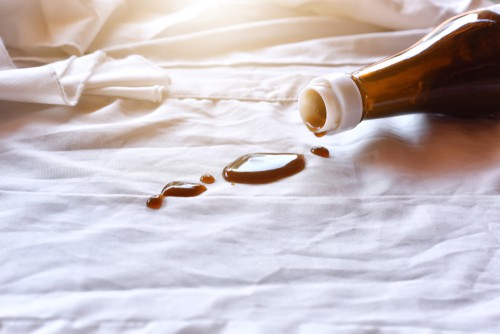
Removing Stains from Shirts and Blouses
Stains on shirts and blouses can often be treated by placing the stained area over a clean towel and applying the stain remover from the back. This allows the stain to be pushed out of the fabric and onto the towel.
Stain Removal Techniques for Pants and Jeans
Pants and jeans can usually handle more vigorous stain removal methods. Rubbing or scrubbing can be more effective, especially on sturdy materials like denim.
Treating Stains on Dresses and Formal Attire
Formal attire or dresses should be treated gently, especially those made from delicate fabrics. Blot the stain, then take to a dry cleaner if necessary.
Laundry Detergents and Stain Removers
Choosing the Right Laundry Detergent for Stain Removal
Choose a laundry detergent with enzymes designed to break down stains. These are typically labeled as “stain-fighting” or “deep cleaning.”
Enzyme-Based Stain Removers: How They Work
Enzyme-based stain removers break down the molecules in the stain, making them easier to wash away. Different enzymes work on different stains, so a variety is often included in these products.
Eco-Friendly and Homemade Stain Removal Solutions
If you prefer a more eco-friendly approach, look for plant-based stain removers. Or you can make your own at home using common household items like vinegar, baking soda, and dish soap.
Precautions and Tips for Success
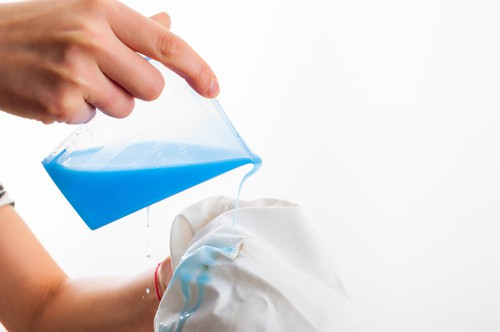
Patch Testing on Unseen Areas
Before using any stain remover, always perform a patch test on an unseen area of the garment. This will ensure that the product doesn’t discolor or damage the fabric.
Avoiding Heat before Stains are Completely Removed
Heat can set stains, so avoid ironing or drying the garment until the stain is completely removed.
Importance of Proper Washing and Rinsing After Stain Removal
After treating the stain, thoroughly wash and rinse the garment to remove any residue. Leftover stain remover can attract dirt or cause damage to the fabric over time.
Preventing Stains in the Future
Tips for Being Cautious with Inks, Oils, and Grease
Always use caution when working with inks, oils, and grease. Use protective clothing or an apron if necessary, and clean up any spills immediately.
Stain Repellents and Fabric Protectors
Consider using a stain-repellent or fabric protector on your clothing. These products create a barrier that causes liquids to bead up on the fabric surface, making it easier to clean up spills before they become stains.
Washing and Storing Clothes to Avoid Future Stains
Always wash stained garments separately to avoid spreading the stain to other items. Store clothes properly, away from dust and moisture, to prevent stains and prolong the life of your clothing.
Frequently Asked Questions (FAQs)
How do I remove old ink stains from clothes?
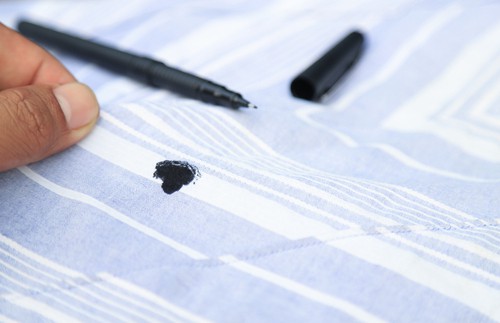
Old ink stains can be difficult to remove, but not impossible. Try an alcohol-based solution, or professional cleaning may be required for stubborn stains.
Can I use bleach to remove ink, oil, or grease stains?
Bleach should only be used on white fabrics as a last resort, as it can damage fibers and cause discoloration.
What should I do if the stain has already set in?
Soaking the garment in a mixture of warm water and a gentle detergent can help for set-in stains. Then treat with a stain remover and wash as usual.
Will using hot water on stains help in removal?
Hot water can help remove some types of stains, but be careful as it can also set certain types of stains. Always check the care label on your garment.
Are there specific home remedies for stain removal?
Home remedies for stain removal include vinegar, baking soda, dish soap, and even hairspray or hand sanitizer for ink stains.
How can I remove ink, oil, or grease stains from delicate fabrics?
Delicate fabrics may require professional cleaning. However, gentle treatment with a mild detergent or specialty stain remover can sometimes be effective.
How to Remove Ink, Oil, and Grease Stains from Clothes? – Conclusion
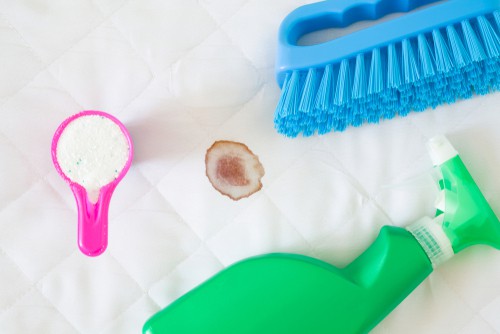
Stain removal can be daunting, but with this comprehensive guide, you can tackle ink, oil, and grease stains effectively. Remember, the key is quick action and using the right methods for your specific stain and fabric type.
By taking prompt action and applying the right stain removal techniques, you can extend the life of your clothes and keep them looking their best.
Don’t let a small spill or spot ruin your favorite outfit. With these tips and techniques, you can confidently confront any stain that comes your way.
Are you seeking a professional and reliable laundry cleaning service in Singapore? Contact us today!




